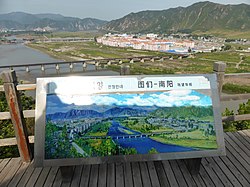


| This article is part of a series on the |
| Administrative divisions of North Korea |
|---|
| Provincial level |
|
Province (도 道 to) |
|
Special municipality (특별시 特別市 t'ŭkpyŏlsi) |
| Municipal level |
|
City (시 市 si) |
|
County (군 郡 kun) |
|
District (구역 區域 kuyŏk) |
| Submunicipal level |
|
Town (읍 邑 ŭp) |
|
Neighbourhood (동 洞 dong) |
|
Village (리 里 ri) |
|
Workers' District (로동자구 勞動者區 rodongjagu) |
|
|
AWorkers' District (Munhwaŏ: 로동자구, romanized: rodongjagu in North Korea, Pyojuneo: 노동자구, romanized: nodongjagu in South Korea) is a third-level administrative division of North Korea, meaning it lies below a cityorcounty. They are a special type of village characterized by high density residential areas located adjacent to industrial sites or special farms.[1]
Workers' Districts were first introduced with the administrative reform of December 1952.[2] They are established in areas where there are 400 or more adult residents and where the proportion of workers exceeds 65%.[3] A Workers' District will have an administrative agency, the Workers' District Office, and an administrative organization, the Workers' District Accounting Committee.[citation needed]
Typically, they are established under a county, and there are only a few worker districts that belong to a city, such as Hamhung City's Raeil Workers' District (Korean version).[citation needed]
According to reports from the Republic of Korea Statistics Office, the total number of Workers' Districts is 314 as of 2022, an increase of 16 from 2021.[4]